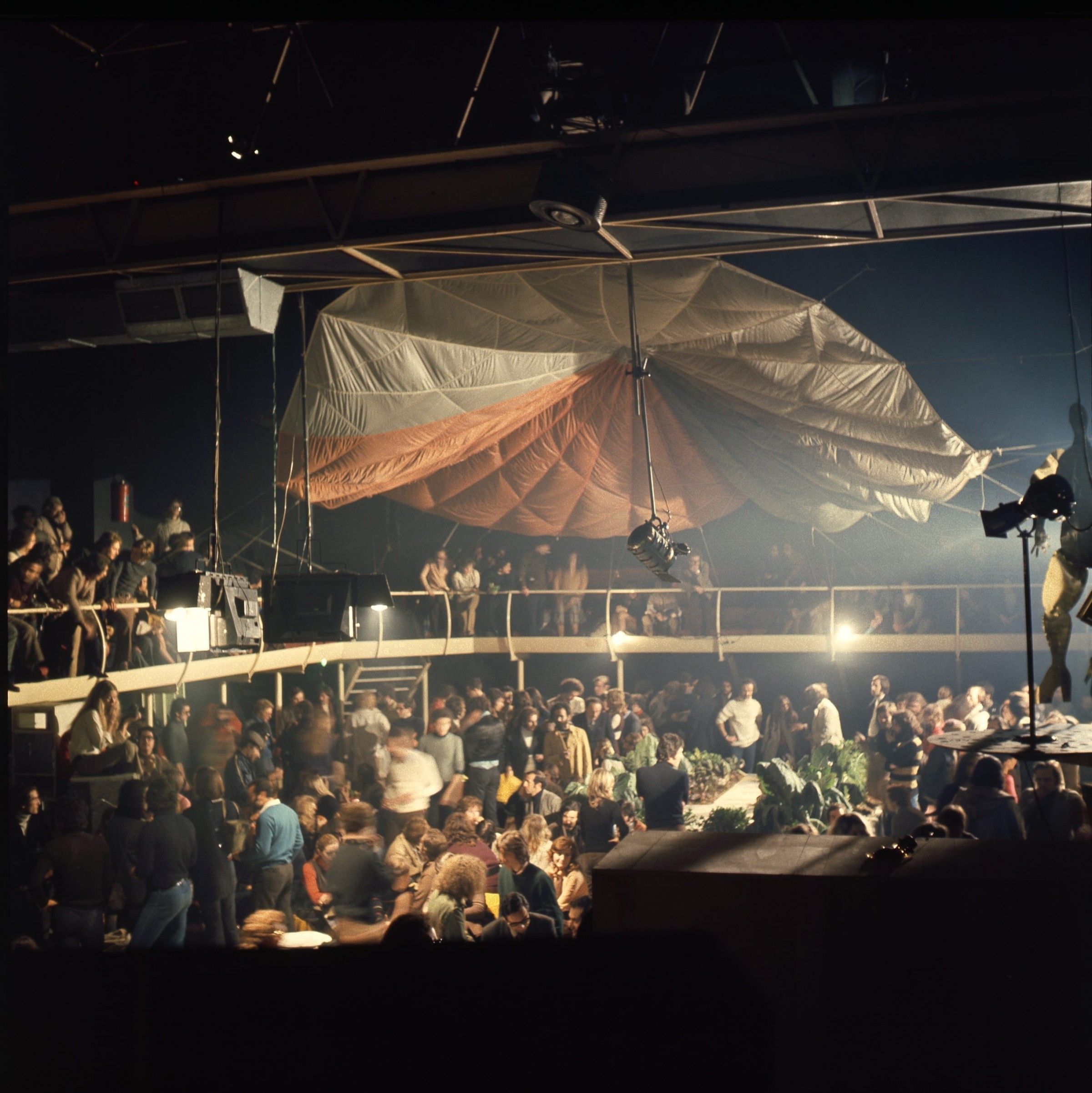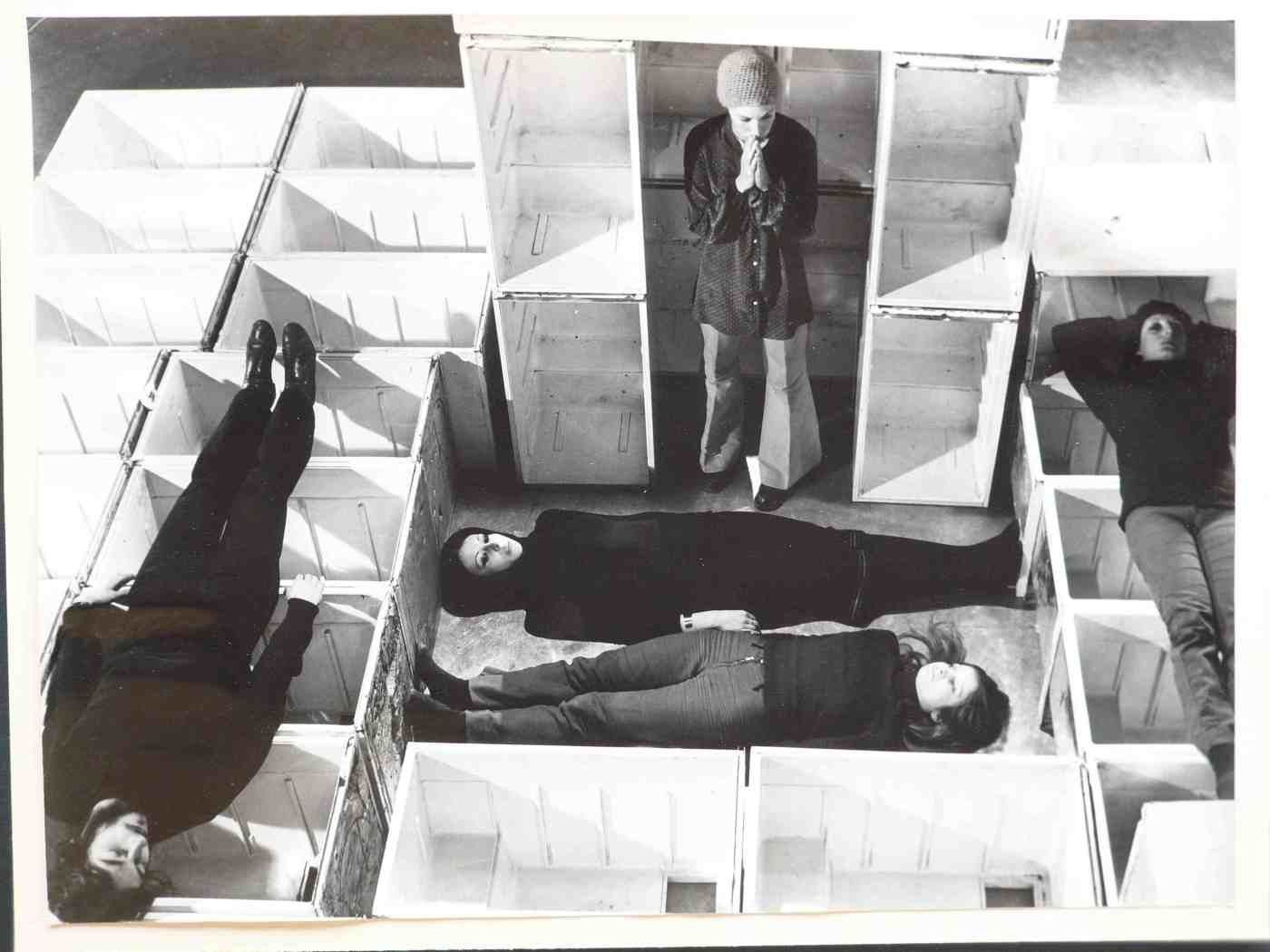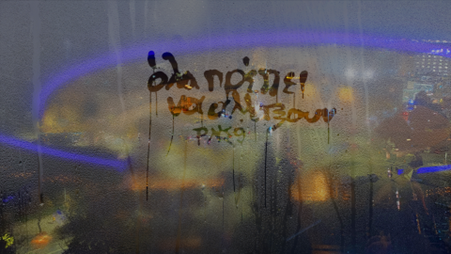Ριζοσπαστική αρχιτεκτονική, Gruppo 9999 και Space Electronic Nightclub
DS.WRITER:
Christina Ioakeimidou
Ο Μάης του ’67, το κίνημα των Χίπις στις ΗΠΑ, καθώς και η ιδιαίτερα μποέμ βρετανική μουσική σκηνή, διαμόρφωσαν ένα κλίμα που προωθούσε τη διαφορετικότητα, με απώτερο στόχο την επίτευξη της ειρήνης, της ισότητας και της απομάκρυνσης από τον καπιταλιστικό τρόπο ζωής, που είχε εκτιναχθεί μετά τον Β’ Παγκόσμιο Πόλεμο. Ο κόσμος έπρεπε να αλλάξει, και την πρωτοβουλία αυτής της αλλαγής την πήρε η νεότερη γενιά, μέσω των φοιτητικών κινημάτων. Η καλλιτεχνική τάση που θα ταυτιστεί με αυτό το γενικότερο κύμα αλλαγών ξεκινά από τη Φλωρεντία, μέσω της ανάπτυξης της Ριζοσπαστικής Αρχιτεκτονικής.
H ριζοσπαστικοποίηση της καλλιτεχνικής έκφρασης
Ο χώρος της αρχιτεκτονικής και του design δεν θα μπορούσε να μείνει ανεπηρέαστος από τις εξελίξεις. Στα τέλη της δεκαετίας του 1960, μία ομάδα νέων Ιταλών καλλιτεχνών και αρχιτεκτόνων αποφάσισε να αντιταχθεί ολοκληρωτικά στο κατεστημένο που χαρακτήριζε τον σχεδιασμό, και την ορθολογική τάση που επικρατούσε τις προηγούμενες δεκαετίες. Η ριζοσπαστικότητα των ιδεών και των προτάσεών τους, η οποία έδωσε και το όνομα στη νέα τάση, βασιζόταν στην ολική και πολυεπίπεδη ανατροπή του συστήματος. Η πίστη τους ότι ο αρχιτεκτονικός σχεδιασμός είναι ένα ακόμα μέσο εξυπηρέτησης των αναγκών τής άρχουσας κοινωνικής τάξης, ήταν στο επίκεντρο της ιδεολογικής τους κατεύθυνσης και της επιθυμίας τους, όχι μόνο να διαμορφώσουν μία νέα Αρχιτεκτονική, αλλά και να συμβάλουν σε μία βαθύτερη αλλαγή, αυτή των ανθρώπινων συνειδήσεων.
Στην ουσία, οι εκπρόσωποι του ριζοσπαστικού αυτού ρεύματος κινούνταν σε απόλυτη ευθυγράμμιση με τα αιτήματα για μία ολική κοινωνική αλλαγή. Κινητήριο δύναμη του όλου εγχειρήματος αποτέλεσε η ίδια η σχολή Αρχιτεκτονικής της Φλωρεντίας και η άρνησή της να αλλάξει το απαρχαιωμένο πρόγραμμα σπουδών. Χαρακτηριστικό είναι πως, μέχρι και τη δεκαετία του 1960, υπήρχαν σημεία στο πρόγραμμα σπουδών, στα οποία γίνονταν αναφορές στη φασιστική περίοδο του ιταλικού κτιριακού σχεδιασμού.
Οι ομάδες της Ριζοσπαστικής αρχιτεκτονικής
Το έργο των διαφόρων ομάδων που ενσωματώθηκαν στη νέα τάση, όπως των Superstudio, Archizoom, U.F.O., Gruppo 9999 αλλά και του βρετανικού Archigram, θα μπορούσε να χαρακτηριστεί φουτουριστικό και ουτοπικό. Γραφικές αναπαραστάσεις, μονολιθικά κτήρια που διαπερνούν ολόκληρες πόλεις, σχέδια κολάζ, όπως το Superface και το εμβληματικό Space Electronic Nightclub στη Φλωρεντία, είναι κάποια από τα γνωστότερα projects που αυτές οι καλλιτεχνικές κολεκτίβες παρήγαγαν, συνεργατικά ή μη.
Η πρώτη -και ίσως σημαντικότερη- ομάδα ήταν η Superstudio. Έχοντας ιδρυθεί το 1966 από τους Cristiano Toraldo di Francia και τον Adolfo Natalini, δύο φοιτητές του πανεπιστημίου της Φλωρεντίας, η ομάδα είχε ως ιδεολογικό πυρήνα την απομάκρυνση από την εννοιολογική κατεύθυνση που ακολουθούσε η αρχιτεκτονική της εποχής, στοχεύοντας στη δημιουργία χώρων που θα σέβονταν και θα κινούνταν ευθύγραμμα με τη φύση. Στόχος αυτών των κατασκευών ήταν, όπως αναφέρει και ο di Francia, «η μνημειώδης επέκταση» της αρχιτεκτονικής, που θα επιτυγχανόταν μέσω πλεγμάτων (grids). Η επιλογή των πλεγμάτων για τις ουτοπικές αυτές κατασκευές δεν ήταν τυχαία, αφού η λογική πίσω από το δίκτυο που αυτά δημιουργούν, θα μπορούσε να έχει και συμβολική υπόσταση. Άλλωστε, τα πολεοδομικά τετράγωνα και η ζωή στις σύγχρονες μεγαλουπόλεις είναι σχεδιασμένα βάσει ενός πλέγματος, έξω από το οποίο το άτομο, σύμφωνα και με τον Rem Koolhaas, είναι σχεδόν ακατόρθωτο να επιβιώσει.

Πηγή εικόνας: commons.wikimedia.org | Από την έκθεση τους MoMa
Η κολεκτίβα, εκτός από τη συμμετοχή -μαζί με μέλη άλλων ομάδων τής Ριζοσπαστικής Αρχιτεκτονικής- στην έκθεση του ΜοΜΑ «Italy: The New Domestic Landscape» (1972), εξέδωσε και κείμενα, με τα οποία επεδίωκε την ανάλυση της ιδεολογίας της. Στο κείμενο του Gian Piero Frassinelli «12 ιδανικές πόλεις», αναφέρεται: «Θέλαμε να δείξουμε 12 στοιχεία πραγματικών πόλεων που έχουν φτάσει στα λογικά τους όρια».
Την ίδια χρονιά, η Superstudio συνεργάζεται με την επίσης ιταλική κολεκτίβα Archizoom, των Andrea Branzi, Gilberto Corretti, Paolo Deganello και Massimo Morozzi. Προϊόντα της ένωσης ήταν το project Superarchitettura και η κοινή έκθεση στην γκαλερί Jolly2 στη Πιστόια. Αν και το κοινό μανιφέστο ήταν ριζοσπαστικό και κατά της παραδοσιακής νόησης του σχεδιασμού, υπήρξε διάσπαση της Superarchitettura σε δύο κατευθύνσεις. Ιδιαίτερο ενδιαφέρον προξενεί η δεύτερη από αυτές, υποστηριζόμενη κυρίως από τα μέλη του Superstudio, αφού έθετε ως στόχο τη συμβολική και ιδεαλιστική προσέγγιση της αρχιτεκτονικής, η οποία θα την κρατούσε απομακρυσμένη από την ακατάσχετη παραγωγική διαδικασία.
Το Gruppo 9999
Το Gruppo 9999 (αρχικά γνωστό με την ονομασία Gruppo 1999) ήταν μία ακόμα καλλιτεχνική κολεκτίβα, περισσότερο ευθυγραμμισμένη με τις αντιλήψεις του Superstudio. Ξεκινώντας επίσης από τη Φλωρεντία, η ομάδα ήθελε να αναπτύξει εργαλεία που θα βοηθούσαν στη δημιουργία μιας δικής της «αυτάρκειας», αρκετά απομακρυσμένης από την πολιτική ιδεολογία, έτσι όπως εκφραζόταν από τις άλλες ομάδες της Ριζοσπαστικής Αρχιτεκτονικής. Με τον τρόπο αυτόν, η αυτάρκεια της ομάδας, και κατ’ επέκταση ολόκληρης της κοινωνίας, θα προερχόταν από τη στροφή σε έναν τρόπο ζωής βασισμένο στη χειρωνακτική κατασκευή και τις εμπειρικές πρακτικές της καθημερινότητας.
Τα ιδρυτικά μέλη της ομάδας ήταν οι Giorgio Birelli, Carlo Caldini, Fabrizio Fiumi και Paolo Galli. Οι Caldini και Preti, έχοντας ταξιδέψει στις ΗΠΑ, επηρεάστηκαν βαθύτατα από το κίνημα των Χίπις και τις διακηρύξεις τους για μια ζωή απλή, απολύτως εναρμονισμένη με το φυσικό περιβάλλον. Όμως, ο φυσικός τρόπος ζωής για το Gruppo 9999 δεν σήμαινε την άρνηση της τεχνολογικής προόδου. Αντιθέτως, τεχνολογία, φύση και τέχνη αποτελούσαν ένα ενιαίο σύνολο, αποστασιοποιημένο από τη σοβαροφάνεια του Μοντερνισμού των προηγούμενων χρόνων.
Ιδιαίτερα σημαντική στάθηκε και η παραμονή του Fiumi στην Καλιφόρνια. Εκεί, γνώρισε σε βάθος την επιρροή τής τεχνολογίας σε όλους τους τομείς της ζωής, γεγονός που τον βοήθησε στην ανάπτυξη θεωριών, που ανάγουν την αρχιτεκτονική σε έναν τρόπο ηλεκτρονικής επικοινωνίας. Η συνύπαρξη της αρχιτεκτονικής και των ηλεκτρονικών μέσων ήταν παρούσα ήδη από τα μέσα της δεκαετίας του ’60 στις ΗΠΑ, με το Electronic Circus Nightclub (έτη λειτουργίας 1967-1971) της Νέας Υόρκης και το Buckminster Fuller της Expo67 του Μόντρεαλ να αποτελούν σύμβολα αυτής της νέας μορφής διασκέδασης. Η καινοτομία αυτή μεταφέρεται με πρωτοβουλία των F. Fiumi και C. Caldini στη Φλωρεντία, οδηγώντας στην ίδρυση του Space Electronic Nightclub. H φράση των μελών της κολεκτίβας «η αρχιτεκτονική του Space Electronic είναι ανύπαρκτη», δείχνει να περικλείει όλη τη φιλοσοφία του συγκεκριμένου χώρου.
Space Electronic Nightclub
Το διώροφο nightclub εγκαινιάζεται στις 27 Φεβρουαρίου του 1969 σε ένα πρώην συνεργείο μηχανών, με την είσοδο στο εσωτερικό του να είναι αρκετά αυστηρή. Λόγω της ολιστικής, μη-κομφορμιστικής προσέγγισης στην κουλτούρα, τη μόδα και το design, οι θαμώνες έπρεπε να ακολουθούν συγκεκριμένες στιλιστικές προτιμήσεις, ενώ η αισθητική των Χίπις ήταν εξέχουσα στον χώρο.
Η τεχνολογία υποδεχόταν τους θαμώνες ήδη από την είσοδο, αφού, μέσω ενός τηλεοπτικού συστήματος παρακολούθησης, αυτοί μπορούσαν να δουν κατευθείαν στο εσωτερικό του club. Το σύστημα, ωστόσο, φαίνεται πως λειτουργούσε και αντιστρόφως, αφού προσέφερε τις εικόνες του εξωτερικού χώρου και στο εσωτερικό. Στο σημείο αυτό είναι φανερή η επιρροή και η εφαρμογή του προτύπου που εξέφρασε ο Καναδός φιλόσοφος M. McLauhan στο Understanding Media (εκδ. ΜcGraw-Hill, 1960), αναφερόμενος σε ένα σύστημα που προσφέρει διασκέδαση σε πραγματικό χρόνο.
Όσον αφορά το εσωτερικό design, αυτό χαρακτηριζόταν από την κάλυψη των μπάνιων με ασπρόμαυρα κεραμικά πλακίδια, τους καθρέφτες σε πολλά σημεία τού κυρίως χώρου, αλλά και τα συνεχώς μεταβαλλόμενα διακοσμητικά στοιχεία των τοίχων, παρμένα τις περισσότερες φορές από μάντρες της περιοχής, ως μια προσπάθεια ανάδειξης της κουλτούρας της ανακύκλωσης και επαναχρησιμοποίησης των διαφόρων αντικειμένων. Την όλη αισθητική εμπειρία συμπλήρωνε το ανοιχτό καλιφορνέζικο αλεξίπτωτο αλλά και το ενυδρείο με πιράνχας στο μπαρ. Τέλος, οι πελάτες μπορούσαν να διαμορφώσουν τον χώρο, κινώντας οι ίδιοι τα φώτα του club ανάλογα με τον ρυθμό της μουσικής. Ως εκ τούτου, ο χώρος έκανε ακριβώς αυτό που είχε αρχικώς υποσχεθεί. Δεν προσέφερε απλώς διασκέδαση, στόχευε στη δημιουργία εμπειριών.

Πηγή εικόνας: 1854.photography | Από το εσωτερικό του Space Electronic.
Η ουσιαστική αλλαγή στο Space Electronic γίνεται το 1971, όταν το υπόγειο μετατρέπεται σε μία ρηχή λίμνη. Στον επάνω όροφο έλαβε χώρα ένα διήμερο συνέδριο, διοργανωμένο από το Gruppo 9999 και την κολεκτίβα του Superstudio. Σε αυτό το «πειραματικό σχολείο», που προοριζόταν για αρχιτέκτονες και καλλιτέχνες, φιλοξενήθηκε και η performance τής επίσης ριζοσπαστικής ομάδας U.F.O., ενώ, στα πλαίσια της όλης διοργάνωσης, στήθηκε ένας ολόκληρος λαχανόκηπος (Vegetable Garden).
Όσο χαοτικός και να φαίνεται ο «κόσμος» που δημιουργήθηκε στο Space Electronic, αντικατοπτρίζει όλη τη φιλοσοφία του Gruppo 9999: την αρμονία που μπορεί να επιτευχθεί ανάμεσα στη φύση και την τεχνολογία. Η αρμονία αυτή βέβαια δεν αφορούσε μόνο το αισθητικό αποτέλεσμα. Όπως έγραψαν και τα μέλη της κολεκτίβας στο Αρχιτεκτονικά Απομνημονεύματα («Architectural Memoirs»), στόχος είναι ο σεβασμός της τεχνολογίας προς το περιβάλλον, μέσω των προσπαθειών ανακύκλωσης και της χρήσης εναλλακτικών πηγών ενέργειας. Είναι φανερό ότι η φουτουριστική ματιά της κολεκτίβας πράγματι έβλεπε στο μέλλον. Σχεδόν μισό αιώνα αργότερα, η συζήτηση επανέρχεται στο θέμα της βιωσιμότητας, της πράσινης ενέργειας και ανάπτυξης και στους νέους τρόπους κατασκευής, που οφείλουν να στηρίζονται σε μία εναρμονισμένη με το περιβάλλον αρχιτεκτονική.
Πηγές άρθρου
Fiumi E. (2018). Orgies on a dancefloor: Space Electronic. Από https://www.theflorentine.net/2018/01/18/space-electronic-flashback/.
Schwartz E. (2019). The Futuristic Italian Nightclub With Vegetable Gardens and Toga Parties. Aπό https://garage.vice.com/en_us/article/evexb7/italian-futurist-nightclubs.
Marco O. (2017). Florence. The radical revolution of the 9999 group. Aπό https://www.domusweb.it/en/architecture/2017/12/20/rivoluzione-9999-la-mostra-che-celebra-la-pratica-manuale.html.
THE CONTINUOUS MONUMENT: AN ARCHITECTURAL MODEL FOR TOTAL URBANIZATION. Aπό http://arch122superstudio.blogspot.com/2012/06/continuous-monument-architectural-model_15.html.
ROUILLARD, DOMINIQUE, et al. “Superarchitecture: The Future of Architecture 1950-1970.” Journal of Architectural Education (1984-), vol. 67, no. 1, Taylor & Francis, Ltd., 2013, pp. 119–21, http://www.jstor.org/stable/42570005.
Αρχιτέκτονες που ονειρεύτηκαν ένα μέλλον χωρίς κτίρια. Από: https://www.protagon.gr/themata/arxitektones-pou-oneireftikan-ena-mellon-xwris-ktiria-44342230231.
Twelve Ideal Cities. Από: http://hiddenarchitecture.net/twelve-ideal-cities/.
Για τον C. Toraldo di Francia στο: https://www.cristianotoraldodifrancia.it/ .





.jpg)


.jpeg)